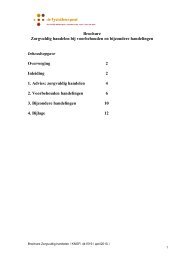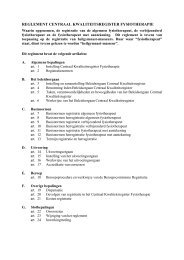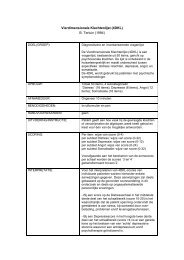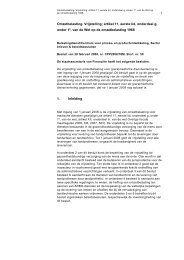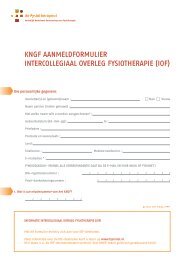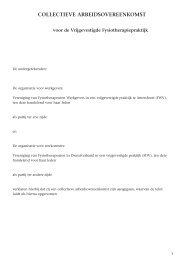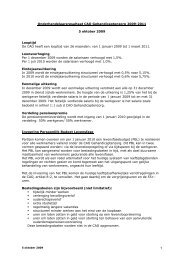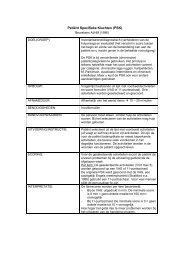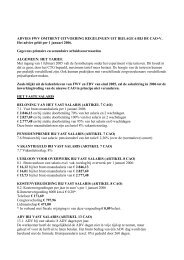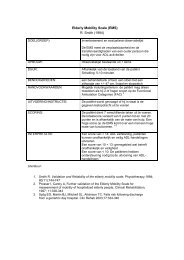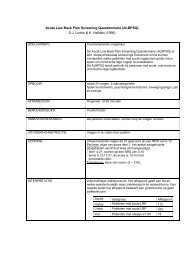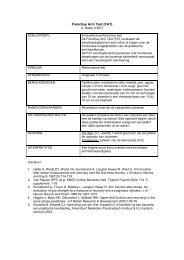Acupuncture and dry-needling for low back pain (Review)
Acupuncture and dry-needling for low back pain (Review)
Acupuncture and dry-needling for low back pain (Review)
You also want an ePaper? Increase the reach of your titles
YUMPU automatically turns print PDFs into web optimized ePapers that Google loves.
Tsukayama 2002<br />
(Continued)<br />
6.4 (other data table)<br />
6.5<br />
6.7<br />
Conclusions: “The results of the present trial showed a significant between-group difference in <strong>pain</strong> relief in favour<br />
of acupuncture”<br />
Von Mencke 1988<br />
Methods<br />
Participants<br />
-R<strong>and</strong>omization procedure not described.<br />
-Patient <strong>and</strong> outcome assessors blinded.<br />
-Setting: Secondary care.<br />
65 patients from an orthopedic clinic with lumbago <strong>and</strong>/or ischias, no relief after conventional treatment<br />
Diagnoses: Lombociatalgia (30), <strong>low</strong>-<strong>back</strong> <strong>pain</strong> (20), LWS Syndrome (10) <strong>and</strong> Ischialgia (5)<br />
Exclusion criteria: neurological problems, scoliosis, concurrent treatment, acute disc prolapse or protrusion, chronic<br />
degenerative disorders, infection<br />
Age <strong>and</strong> gender: not described.<br />
Heterogeneous population regarding type, location <strong>and</strong> duration of disorder<br />
Interventions 1) Manual acupuncture, traditional meridian acupuncture or trigger points, rotation, insertion 0.2 to 3 cm, 6 to 12<br />
needles 5 to 20 minutes, 8 treatments. Training & experience of acupuncturists unknown.<br />
Points:<br />
- Posterior: GV20, BL26, 31,33, 35, 48, 50, 54, 57, 58, 60.<br />
- Lateral: GV20, GB 26, 28, 30, 32, 34, 37, 38, 40. BL 26, 31, 33, 48, 60<br />
- Anterior: GV 20, ST 36, 40. BL 31, 33, 48, 60.<br />
R<strong>and</strong>omized to this group: 35<br />
2) Sham acupuncture, no traditional acupuncture nor trigger points.<br />
R<strong>and</strong>omized to this group: 30<br />
Outcomes<br />
Notes<br />
1) Pain (VAS)<br />
2) Global improvement<br />
3) Schober’s test<br />
4) Lasegue’s test<br />
Language: German<br />
Publication: full paper<br />
No additional in<strong>for</strong>mation from authors<br />
Results:<br />
1) Improvement in <strong>pain</strong> at short-term fol<strong>low</strong>-up: acupuncture=55%; sham acupuncture=37%. Long-term: 44%<br />
versus 30%.<br />
2) Global improvement: acupuncture=94%, sham acupuncture=50% (Table 10.02).<br />
3) Increase in Shober test: short-term: acupuncture=6.4, sham acupuncture=2.7. Long-term: 7.8 versus -0.9<br />
4) Lasegue: short-term: acupuncture=6.0, sham acupuncture=2.2. Long-term, acupuncture=6.7, sham acupuncture=<br />
0.6<br />
Conclusions: “The difference in improvement between typically <strong>and</strong> atypically treated patients was highly significant<br />
(p



